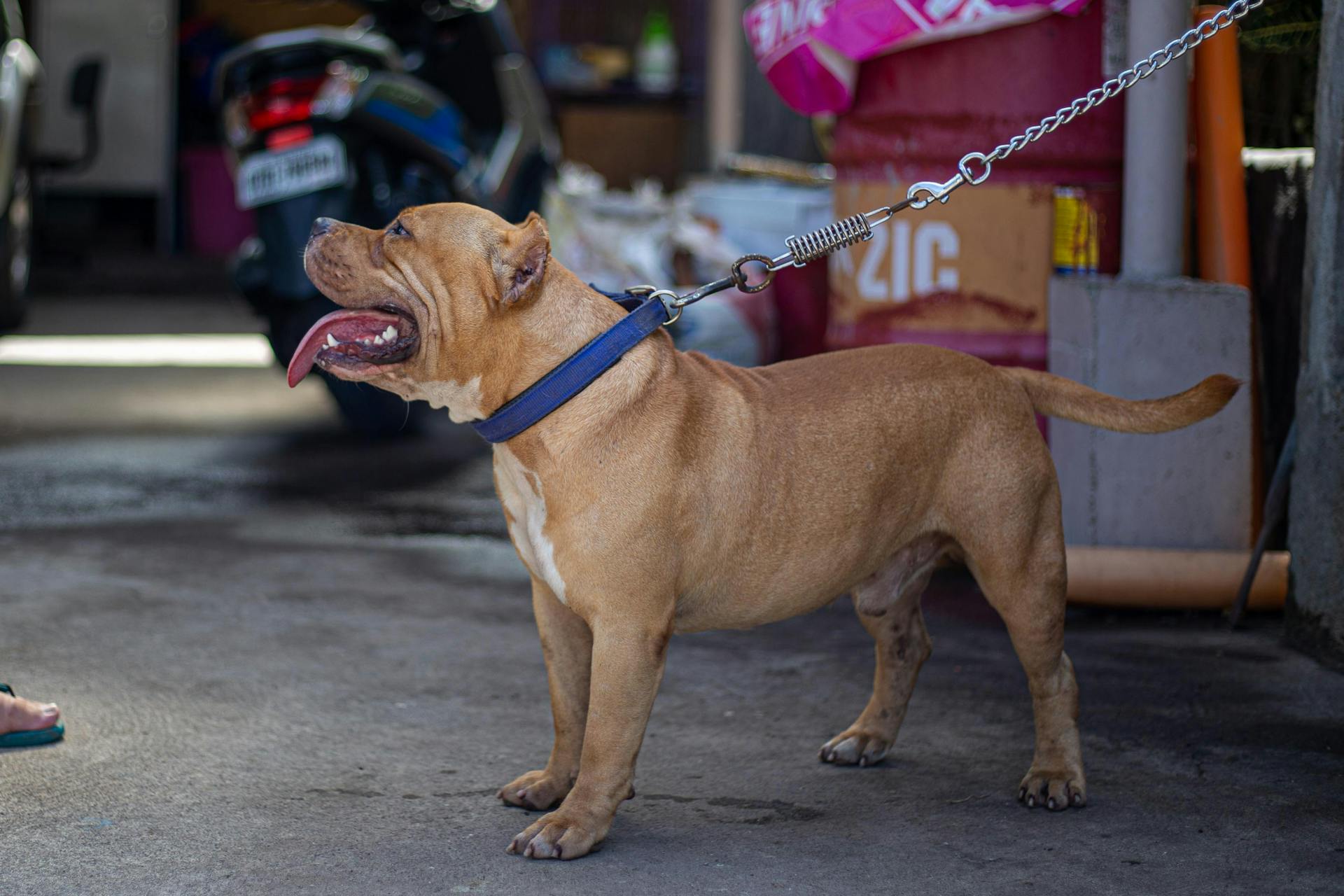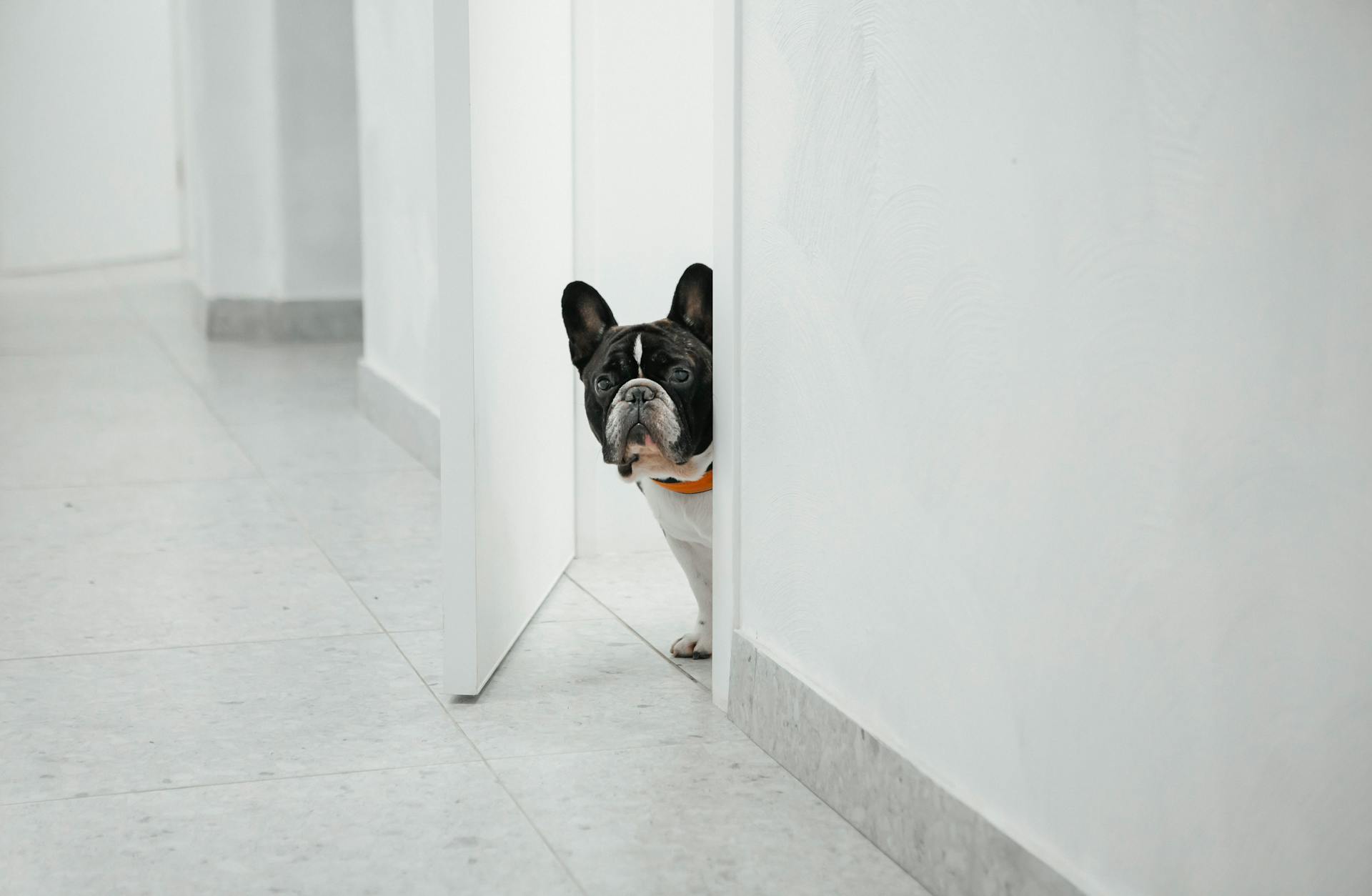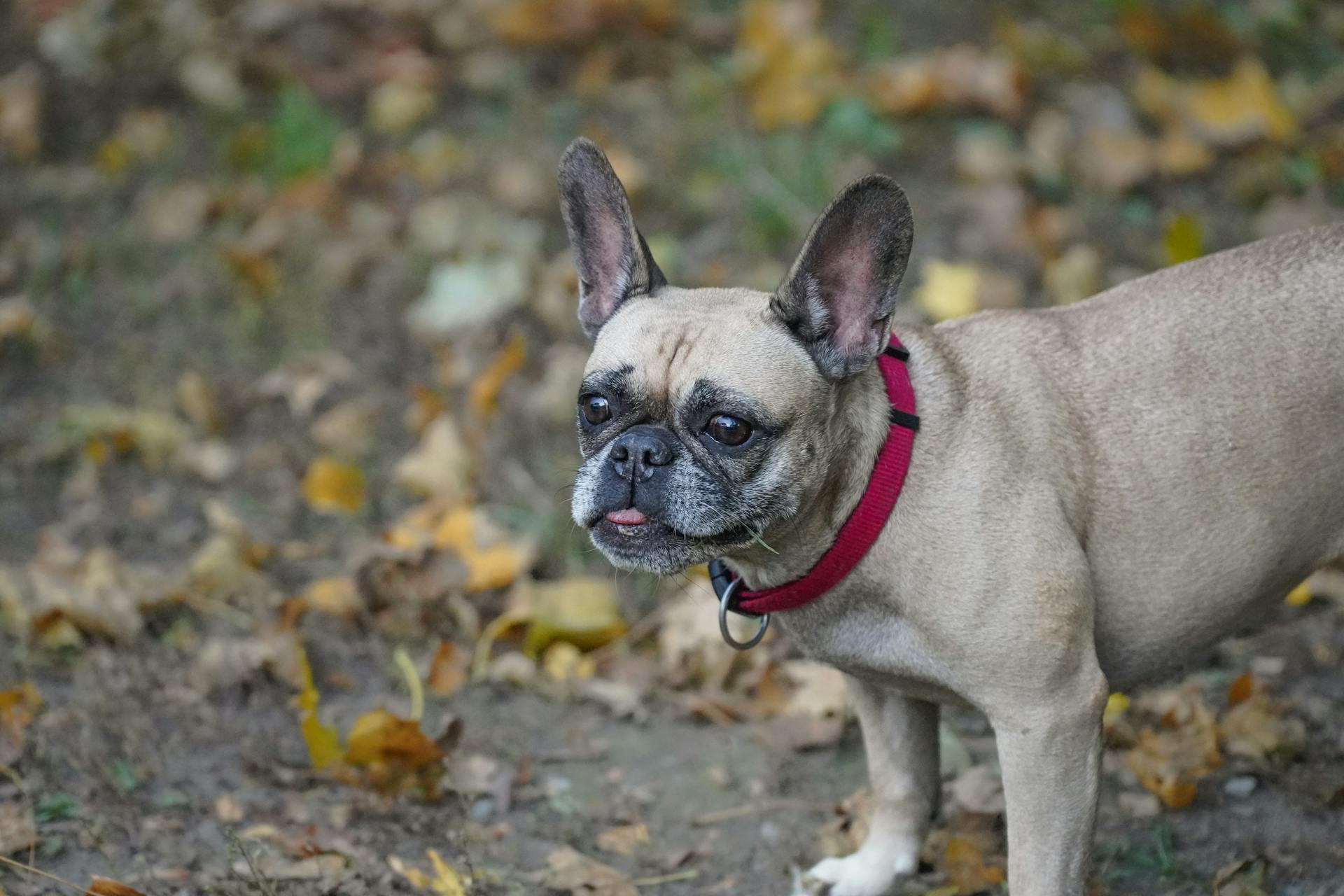
The English Bulldog: A Lovable Companion for Many.
They were originally bred for bloodsports like bull baiting and bear baiting, which is why they have such a strong jaw and tenacious grip.
English Bulldogs are known for their laid-back nature, making them perfect companions for families with children or for people who want a low-maintenance pet.
Physical Characteristics
English Bulldogs are easily recognizable by their sturdy build and broad chest, giving them a powerful yet compact physique.
Their iconic wrinkled face features a pushed-in nose, which is a characteristic of brachycephalic anatomy. This unique feature, combined with their expressive, droopy jowls, lends them a charming and sometimes comical expression.
English Bulldogs typically weigh between 40 and 55 pounds, with males weighing slightly more than females.
Characteristics
English Bulldogs are a medium-sized breed, standing between 12 and 16 inches tall at the shoulders.
Their sturdy build is characterized by broad shoulders and short, sturdy legs that make them move quite slow.
The average English Bulldog weight is between 40 and 50 pounds for females and 50-55 lbs for males.
Bulldogs have a distinctive wrinkled face with deep folds of loose skin starting on the forehead and extending down to the jowl. Their anatomy is classified as brachycephalic, meaning they have a short muzzle and eyes set wide above it.
They come in a variety of colors, including white, fawn, red, and brindle, often with additional markings such as white or black masks.
Expand your knowledge: How Much Food Should a 50 Lb English Bulldog Eat
Grooming
The Bulldog's grooming needs are relatively low-maintenance.
Their short coat requires little more than a soft brush two to three times a week to keep them looking their best.
However, the wrinkles on their face need regular attention to prevent moisture and food from getting trapped and causing skin infections or irritations.
Temperament and Behavior
The English Bulldog is a gentle soul, known for their sweet and dependable nature. They're relatively predictable, which makes them easy to live with.
Bulldogs are great with kids and love human attention, making them perfect family pets. They thrive on companionship and form strong bonds with their families. With proper training and socialization, they can even get along well with other dogs.
Despite their courageous side, Bulldogs are generally friendly and approachable, which makes them excellent watchdogs in a way. However, it's essential to remember that they can be aggressive towards dogs they don't know without proper introduction.
Personality and Behavior
Bulldogs are known for their gentle and affectionate nature, making them a great addition to families with children.
They thrive on companionship and form strong bonds with their families, often becoming "lap dogs" due to their love of cuddling.
A Bulldog's disposition should be equable and kind, resolute, and courageous (not vicious or aggressive), and demeanour should be pacifist and dignified. These attributes are countenanced by the expression and behaviour.
Despite their intimidating appearance, Bulldogs can be quite courageous and make excellent watchdogs when necessary.
Bulldogs get along well with other pets but can be aggressive to dogs they don’t know without proper training and socialization.
Their loyal and loving nature makes them a great fit for families who want a friendly and approachable companion.
Explore further: English Bulldog and Great Dane Mix
Training
Training is a vital part of raising a well-adjusted English Bulldog.
Establishing a consistent routine including feeding schedule, outdoor time, and training routine will help your Bulldog to learn quickly what is expected of them in your home. This will make the rest of the training much easier.
Bulldogs have a reputation for being stubborn, which can present challenges during training. However, with patience, consistency, and positive reinforcement techniques, Bulldogs can be trained effectively.
Begin training and socializing your English Bulldog puppy as soon as you bring them home. Like all dogs, Bulldogs respond best to positive reinforcement training.
Just be mindful about how many treats you’re giving your dog during training sessions, as treats can lead to unwanted weight gain. Treats should never make up more than 10% of your dog’s daily calorie intake.
Early socialization is crucial to help Bulldogs develop good manners and interact positively with people and other animals. Exposing them to various experiences and environments from a young age can help prevent shyness or aggression.
Bulldogs love to chew, so be sure to provide them with a variety of toys designed to stay tough.
See what others are reading: English Bulldog Skin Allergies Home Remedies
Health and Care
English Bulldogs are prone to certain health issues due to their brachycephalic breed class and physical characteristics.
Regular grooming is essential for English Bulldogs as it helps keep them clean and comfortable. Brushing their short coat once or twice a week can prevent matting, while bathing should be done only when necessary to avoid skin irritation.
Some common health issues in English Bulldogs include hip dysplasia, stenotic nares, elongated soft palate, and brachycephalic airway syndrome. These conditions can lead to breathing difficulties, heatstroke, and other complications if left untreated or poorly managed.
Here are some specific health concerns that English Bulldog owners should be aware of:
- Brachycephalic airway syndrome
- Hip dysplasia
- Keratoconjunctivitis sicca (dry eye)
- Stenotic nares
By being informed and taking proactive steps, English Bulldog owners can minimize the risk of these health issues and ensure their pets live happy and healthy lives.
Key Takeaways
As you care for your German Shepherd, here are some key takeaways to keep in mind:
German Shepherds can live up to 10-13 years with proper care and nutrition.
You might like: Yorkshire Terrier Care

They require regular exercise to stay healthy and happy, but be aware that they can get hip dysplasia if they don't get enough physical activity.
To minimize the risk of this condition, make sure your German Shepherd gets at least 30 minutes of exercise per day.
Here are some specific health concerns you should be aware of:
* Hip dysplasia: A genetic condition that can cause arthritis and mobility issues in older dogs.Shoulder luxation: A condition where the shoulder joint becomes dislocated, which can be painful for your dog.
It's essential to work with a reputable breeder who prioritizes health testing and responsible breeding practices.
You might enjoy: English Bulldog Hip Dysplasia
Lifespan
The lifespan of English Bulldogs can vary significantly depending on several factors.
A 2022 study found that the breed has a life expectancy of around 7-9 years, which is one of the lowest among all breeds. This is compared to an average of 12.7 years for purebreeds and 12 years for crossbreeds.
Cardiac-related issues are a leading cause of death in Bulldogs, accounting for about 20% of fatalities, followed closely by cancer at around 18%. Old age also plays a significant role, with nearly 9% of deaths attributed to it.
If this caught your attention, see: English Bulldog 100 Years Ago
Health Issues

English Bulldogs are prone to a range of health issues due to their unique physical characteristics.
One of the biggest concerns with this breed is heatstroke, which can be fatal if not treated promptly. Regular veterinary check-ups and proper care can help minimize the risk of these health issues.
Bulldogs often require C-sections when giving birth, making pregnancy a high-risk period for them. Their short muzzle and narrow airways make it difficult for them to breathe, especially in hot weather or during exercise.
Some common health issues affecting English Bulldogs include hip dysplasia, shoulder luxation, and stenotic nares. These conditions can be costly to treat, with prices ranging from $300 to $7,500.
Regular grooming is essential to prevent skin fold dermatitis and other skin issues in Bulldogs. Brushing their short coat once or twice a week can help remove loose hair and prevent matting.
Bulldogs are prone to eye problems due to their facial structure, so it's crucial to keep the area around their eyes clean and dry. Regular ear cleaning with a veterinarian-approved solution can also help prevent infections.
For your interest: Ruby Short Hair Cavalier King Charles Spaniel

Here are some common health issues in Bulldogs:
- Hip dysplasia
- Shoulder luxation
- Ventricular septal defect
- Keratoconjunctivitis sicca (KCS or dry eye)
- Stenotic nares
- Internalized tail
- Elongated soft palate
- Elbow dysplasia
- Distichiasis
- Patellar luxation
- Ectropion
- Entropion
- Cherry eye
- Demodicosis
- Urethral prolapse or vaginal hyperplasia
By being aware of these potential health issues, you can take steps to prevent them and ensure your English Bulldog lives a happy and healthy life.
Nutrition and Diet
English Bulldogs love to eat, which can lead to weight gain if not monitored closely.
Work with your vet to determine the right amount of food for your dog daily and avoid feeding table scraps or extra treats.
Treats should make up no more than 10% of your dog's daily caloric intake and be given sparingly as training rewards.
Many English Bulldogs exhibit extreme possessiveness of their food, which can be serious if not controlled - talk to your vet about how to reduce this behavior in your pet.
A well-balanced diet is essential for maintaining the health and vitality of English Bulldogs.
For another approach, see: English Bulldog Vet
Health Conditions
English Bulldogs are prone to a range of health issues due to their unique physical characteristics.
One of the most significant concerns is hip dysplasia, with 73.9% of Bulldogs tested between 1979 and 2009 affected by this condition. This is the highest incidence amongst all breeds.
Bulldogs also have a nearly three times greater risk of patellar luxation, with 2.9% of all Bulldogs having the condition. Their brachycephalic breed class means they can experience respiratory problems due to their short head and snout.
In fact, heat is a special concern for English Bulldogs since they aren't able to cool themselves efficiently through panting. Heatstroke is also more common compared to other breeds.
Their unique airways make it difficult for them to breathe properly, which can lead to complications while under anesthesia. Some of the most common health issues affecting English Bulldogs include hip dysplasia, shoulder luxation, ventricular septal defect, and keratoconjunctivitis sicca (KCS or dry eye).
Other health concerns specific to this breed include stenotic nares, internalized tail, elongated soft palate, elbow dysplasia, distichiasis, patellar luxation, ectropion, entropion, cherry eye, and demodicosis. Bulldogs are also prone to skin fold dermatitis, with 17% of those surveyed in a 1963 UK study having this condition.
For another approach, see: English Bulldog Hip Dysplasia Treatment
Their facial and body wrinkles need to be kept clean and dry to prevent skin infections and other issues. Regular grooming can help keep your Bulldog clean and comfortable, but it's essential to address these specific health concerns as well.
Here are some common English Bulldog health issues:
- Hip dysplasia
- Shoulder luxation
- Ventricular septal defect
- Keratoconjunctivitis sicca (KCS or dry eye)
- Stenotic nares
- Internalized tail
- Elongated soft palate
- Elbow dysplasia
- Distichiasis
- Patellar luxation
- Ectropion
- Entropion
- Cherry eye
- Demodicosis
It's essential to work with reputable breeders who screen their genetic stock for conditions that can affect the breed. Regular veterinary check-ups and preventative care can also help identify potential issues early on, reducing the risk of costly treatments down the line.
Living With Them
Bulldogs make fine indoor pets and don't require a yard.
They thrive best in temperate climates as high temperatures cause them to overheat and have breathing difficulties.
Being low-endurance dogs, they're not suitable for people who wish to have their dog keep up with an active lifestyle.
If you're single, retired, or have a young family, these dogs might be a perfect choice, as long as you have time to spend relaxing at home with them.
Bulldogs aren't known to be barkers, but they can make lots of noises, especially when they're sleeping.
They'll snort, wheeze, and snore due to their short muzzle and breathing difficulties.
Many members of this breed also drool.
Be sure to have lots of durable toys and ropes available because Bulldogs love to chew.
Frequently Asked Questions
Are English bulldogs expensive?
Yes, English bulldogs are considered a moderately expensive breed, with initial costs ranging from $1500-$2000. Over their lifetime, owners can expect to spend around $15,000-$18,000 on total expenses.
Are English bulldogs high maintenance?
English Bulldogs require special care, but with understanding and dedication from owners, they can be a wonderful addition to any family. While some extra attention is needed, they're not necessarily the most difficult dog to own.
Are English Bulldogs dog friendly?
English Bulldogs are generally good with family pets, but may be aggressive towards unfamiliar dogs due to their protective nature.
How big do English Bulldogs get?
English Bulldogs typically weigh between 40-55 pounds and stand 12-16 inches tall. Males are slightly larger than females.
How to tell if an English Bulldog is purebred?
An English Bulldog's purebred status can be identified by its distinctive physical characteristics, such as a sturdy physique with broad shoulders and short, thick neck. A reputable breeder or veterinarian can confirm the dog's ancestry through documentation and examination
Featured Images: pexels.com


